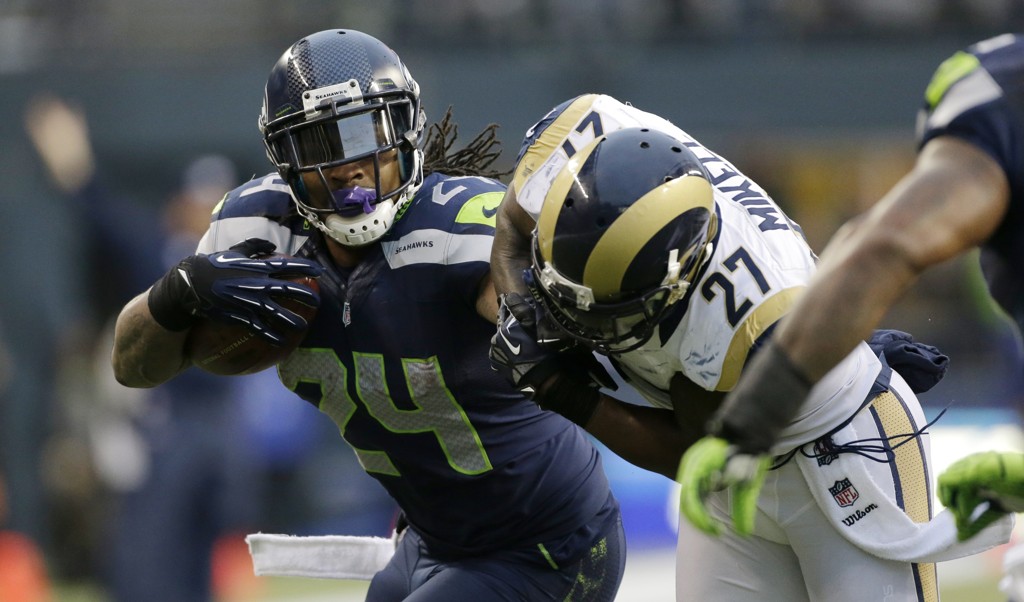The NFL playoffs are such a unique spectacle. Nowhere else in the realm of postseason sports is the “winner-take-all” mentality a bigger part of the game, and while collegiate football’s regular season can at times rival the pro version of the sport in intensity, there is little real change come postseason due to the bowl process currently in place.
As for the pros, you can literally feel things tighten up come early January. Referees are less willing to call penalties they would have flagged during the regular season. The game becomes more of a street fight, and that has enabled teams like the Ravens, Jets and Steelers to thrive at times during the second session while none have proven to be great regular season units, for the most part.
This past weekend, the NFL gave us four divisional games which all mimicked the physical and intense nature described. The first tilt, an NFC showdown between the Saints and Seahawks, saw New Orleans come out and pound the ball on the ground at an almost 5-1 clip in the first quarter. They had to throw it more during a second half which found them down by two possessions most of the time. Nonetheless, the Saints’ backs were unable to keep pace with Marshawn Lynch and his 28 carries, but it didn’t stop them from trying.
The nightcap on Saturday featured a New England team with maybe’s the league’s best quarterback. They opted to run it 46 times to only 25 throws. That mentality was as much about Indy’s incompetence in defending the run as anything else, but still illustrated Bill Belichick ability and willingness to think outside the box.
Sunday’s games saw two unders hit and 74 total points scored between them. San Francisco and Carolina ultimately had to throw it more than either would have liked, as match-ups and score dictated much of the tempo throughout.
Like Brady, fellow Q.B. legend Peyton Manning engineered an offense that was balanced 50/50 when it came to play-calling in the last game of the weekend. Knowshon Moreno handled the ball 23 times and Montee Ball pitched in with an additional 10 carries. Manning had match-ups against the Charger secondary, but opted to play with a different reverence for pace than he would typically show.
San Diego was forced to throw the football in the second half as a result of being down by multiple scores, but they too clearly desired to run it. They got only five carries from Ryan Mathews because of ankle ailments. Had he been healthy, we may have seen an even tighter grind.
Like any sport, things change week to week. Coaches and game planners will alter their motives as they head into the championship session this Sunday, and that could lead to more passing. It’s hard to imagine the DEN-NE game not coming down to last minutes drives by Brady and/or Manning. And those drives would undoubtedly put the ball in the hands of the man under center no matter the scenario or score.
But it’s incredibly interesting to see just how much these two, among other offensive minds, have come to bank on the ground attack come playoff time. When these two first met back in week 12, Manning gave the ball to Moreno a whopping 37 times resulting in 224 yards and a touchdown. Sure, each quarterback wants the ball when the clock is ticking down, but an innate knowledge of balance, match-ups and game management has seen each mix it up more so this season as opposed to previous times.
In the NFC, run-oriented attacks define both the conference finalists as they head into Sunday. Frank Gore and Lynch are true “bell-cows” capable of carrying it 25 times each week if necessary. Both backs have struggled to put up big yardage figures within this series, but have each had success nonetheless in controlling the clock for their quarterbacks.
Getting to the playoffs in this league comes down to your ability to win games which often involve absurd scores. Pittsburgh was left sitting on the outside looking in primarily because of a defense which allowed too many large scoring figures early on in the year. Their offense lacked the ability to make up for that at the time, and it cost them.
The key to getting home field and/or having a legitimate chance to take home the ultimate prize, and not simply be a minute part of the bracket destined to lose, is manifested in both a self-awareness of your style and a commitment to that approach which enhances consistency over the course of the regular season and on into the second season.
Seattle has had miniscule offensive YPP metrics, especially when it comes to the pass. They are built on a dynamic defense and forceful run game, and are thus comparable to their Bay area opponents here. They arrive in the NFC title game with limited aerial success, a component also similar to their counterpart. Denver and New England are pass-happy teams, but both have made the concerted effort to revamp their style so as to include such a rush component.
But the common denominator in all of this is that the four teams here were more willing than their opponents to play a physical brand of football when it mattered most. Airing it out on weaker secondaries is something anyone can do in weeks 1-17.
Winning in the playoffs clearly involves more. Either way, all four are staring down at a potential trip to the biggest game of all. They provide a nice reminder of what playoff football really entails, and that your willingness to uphold such a commitment can only happen when you also possess the skill, willingness and overall toughness to make it work.







